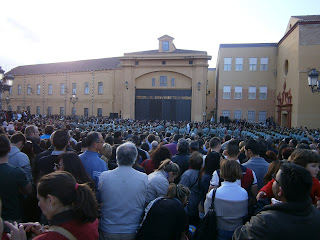This will be the last post although I may add a few notes at some point.
For instance I have been trying to find out about a ruined house mentioned (w/c 12 March) - some information is included later – and if
I find out more I will add it subsequently
Since Easter I have had three sets of visitors, which has been great.
The first, already noted in a previous post came during Semana Santa. One of my
(4) brothers-in-law came over for three days Friday 13th to Monday
16th. We managed plenty of walking between the heavy showers and
dodging the rain in various tavernas meant we drank more cerveza than
intended. Over here, you pay as you leave, not as you go along. Neither of us
could remember paying at the Bodega Bar and we had tapas as well as drinks but
we went back next day (.. and I have been since) and we were not marched out so
we must have paid.
This last weekend my sister-in-law and her husband came over. The
weather was marvellous. As well as a fair bit of walking we also did a tour of
villages (… including The Smurf village of Júzcar –
refer 13 – 19 February). During one of
the walks on Sunday we heard a cuckoo. Ever since I started as a paper boy
(illegally – aged 11) when my first round was in a spread out country area of
Warwickshire, the first cuckoo is something I have always looked forward to and
April 22nd is probably the earliest I have experienced .. (… the
cuckoo comes in April, sings its song in May, changes its tune in merry June
and in July it flies away….). Unfortunately, although birdsong was strong in the Thorpe Meadows area and
woodpeckers were relatively common, there were three Springs out of fourteen
that I spent in that part of Peterborough when I did not hear a cuckoo at all.
During the tour of villages, we visited Zahara de la Sierra and
photos of that are included here.
On Sunday morning I managed to lock us out. I had a key in the inside
of the front door in case my visitors wanted to go outside while I was preparing
breakfast. On leaving I forgot to remove it and after closing the door realised
what I had done. The other key therefore of course would not work – I tried it!
All windows were closed and the downstairs windows anyway have decorative (and
secure) metal bars. The upstairs windows were also closed. I have a small rear
courtyard with a c12 foot high wall separating the neighbour’s courtyard from
mine. As tends to be the case here, there are three generations living next
door – the owners, their children and one set of parents (usually those of the
lady). The old mother answered when I rang the bell but did not understand – or
did not want to understand – my pleas for help. Her daughter though was there
and understood my predicament. On their
side the wall is (only) c9 feet and they had a small set of stepladders. We put
a chair on a table and I was able to reach the stepladders over but had to be
very careful as the necessary drop caused the ladders to bounce, which could
have toppled them. Incredibly they stood up! I then climbed over and carefully lowered myself
onto the ladders which again incredibly stayed upright. There were many ‘oohs’ and ‘aahs’
from the old lady and much hysterical laughter from the younger. My in-laws in
the meantime were discussing where they might stay if I was unsuccessful and
wondering what the emergency services number was if I had fallen (.. 112 in
Andalucia, not 911 or 999).
I am now preparing to leave and hope to have most packing sorted
so that I can relax over the weekend. On Saturday I shall have a few drinks and
a meal with some of the friends I have made. I leave on Monday, stay in
Palencia that night (300 miles), then drive to Santander ( 310 miles) and from
there take the ferry to Plymouth on Wednesday, arriving on Thursday evening
when I will stay with my mother-in-law in Bridgwater and will get back to
Peterborough some time on Friday afternoon.
I will be back in Ronda in October and will again stay over the
Winter – until March.
Having researched the ruined house mentioned at the start it seems
the story is that the owners had an 8 year old daughter who was murdered and
her body was placed in the nearby tower. Her ghost is said to haunt the ruins.
Another version states that the owner was a successful local dignitary who led
a secret life as a warlock and his daughter was murdered. Both stories talk about
paranormal activity at the site and there are even rumours of extra terrestrial
visitations…………….. to be concluded.














